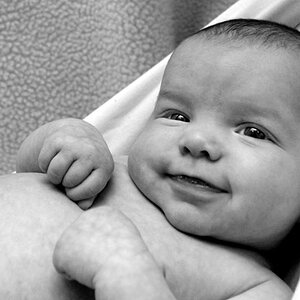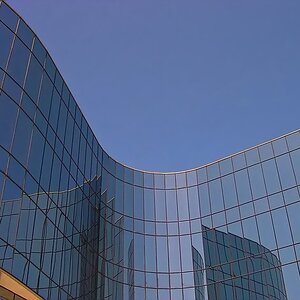Navigation
Install the app
How to install the app on iOS
Follow along with the video below to see how to install our site as a web app on your home screen.

Note: This feature currently requires accessing the site using the built-in Safari browser.
More options
You are using an out of date browser. It may not display this or other websites correctly.
You should upgrade or use an alternative browser.
You should upgrade or use an alternative browser.
Is exposure compensation redundant when going full manual?
- Thread starter larry909
- Start date
jaomul
Been spending a lot of time on here!
- Joined
- Feb 4, 2011
- Messages
- 5,715
- Reaction score
- 1,554
- Location
- Cork Ireland
- Can others edit my Photos
- Photos OK to edit
If doing everything manual exposure compensation is redundant. It's not even possible as you are setting every parameter
I am recently using manual mode with auto iso so I can decide my aperture and speed allowing the iso to fluctuate as required. Exposure compensation is still good to have here imo (though not all cameras have this function)
Edited for spelling mistake
I am recently using manual mode with auto iso so I can decide my aperture and speed allowing the iso to fluctuate as required. Exposure compensation is still good to have here imo (though not all cameras have this function)
Edited for spelling mistake
Last edited:
- Joined
- Jun 23, 2015
- Messages
- 8,524
- Reaction score
- 6,427
- Location
- Petawawa, Ontario
- Website
- www.trevorbaldwin.space
- Can others edit my Photos
- Photos NOT OK to edit
Can't speak for other cameras but every Canon I've ever shot, in full manual there is no exposure compensation. The function doesn't exist.
Cody'sCaptures
No longer a newbie, moving up!
- Joined
- Jan 31, 2017
- Messages
- 253
- Reaction score
- 103
- Location
- Chicago
- Can others edit my Photos
- Photos OK to edit
It will affect your metering.If you're using manual ISO, shutter, and aperture settings, is exposure compensation not needed? Is it only useful when in auto mode?
Sent from my SM-G920T using Tapatalk
- Joined
- Jun 23, 2015
- Messages
- 8,524
- Reaction score
- 6,427
- Location
- Petawawa, Ontario
- Website
- www.trevorbaldwin.space
- Can others edit my Photos
- Photos NOT OK to edit
Not quite.It will affect your metering.
Exposure compensation will use the meter reading and adjust the image exposure based of the + or - adjustment set.
Destin
Been spending a lot of time on here!
- Joined
- Sep 11, 2010
- Messages
- 3,864
- Reaction score
- 1,383
- Location
- Western New York
- Can others edit my Photos
- Photos OK to edit
Not quite.It will affect your metering.
Exposure compensation will use the meter reading and adjust the image exposure based of the + or - adjustment set.
On a Nikon at least, even in full manual, EC changes the “center” point on your meter.
If you add a stop of EC and center the meter, even in manual mode, it will make your image a stop brighter.
- Joined
- Dec 16, 2003
- Messages
- 33,896
- Reaction score
- 1,853
- Location
- Edmonton
- Website
- www.mikehodson.ca
- Can others edit my Photos
- Photos NOT OK to edit
Depends on your camera. As some of the posts are already pointing out, on some cameras (Canon for example), exposure compensation doesn't even exist when you are in manual mode. So in that case, your initial intuition is correct (it doesn't matter).
However, for some stupid reason, Nikon allows for exposure compensation, even when the camera is in manual mode. In this case, it changes the calibration of the meter. So if you have it set to +1.0 and you meter to zero, your exposure would actually be one stop brighter than zero.
My advice to my students who shoot with a Nikon, is that when they are in manual, they should be have their EC set to zero.
However, for some stupid reason, Nikon allows for exposure compensation, even when the camera is in manual mode. In this case, it changes the calibration of the meter. So if you have it set to +1.0 and you meter to zero, your exposure would actually be one stop brighter than zero.
My advice to my students who shoot with a Nikon, is that when they are in manual, they should be have their EC set to zero.
Gary A.
Been spending a lot of time on here!
- Joined
- Sep 17, 2014
- Messages
- 22,357
- Reaction score
- 7,540
- Location
- Southern California
- Website
- www.garyayala.com
Adding my voice to the choir, Yes it is.
benhasajeep
No longer a newbie, moving up!
- Joined
- May 4, 2006
- Messages
- 4,020
- Reaction score
- 497
Exposure compensation is used to mess up your photo's you intend to take the next session with the camera. 
 Sorry, could not resist.
Sorry, could not resist.
It may or man not be redundant. But I think if your already in manual mode. It's slower! At least on Nikon's. You have to move your shutter finger off the shutter, hold the exp comp button, other appendage to make the actual adjustment. And move everything back to take the picture. When if you just go ahead and make a change with your command wheel or sub-command (if you have one), your done. Especially if your using a grip!

 Sorry, could not resist.
Sorry, could not resist.It may or man not be redundant. But I think if your already in manual mode. It's slower! At least on Nikon's. You have to move your shutter finger off the shutter, hold the exp comp button, other appendage to make the actual adjustment. And move everything back to take the picture. When if you just go ahead and make a change with your command wheel or sub-command (if you have one), your done. Especially if your using a grip!
TCampbell
Been spending a lot of time on here!
- Joined
- Mar 31, 2012
- Messages
- 3,614
- Reaction score
- 1,556
- Location
- Dearborn, MI
- Can others edit my Photos
- Photos OK to edit
If you are setting _every_ setting manual than yes... it's redundant (on any camera).
This is because there are only three things that camera can change to adjust exposure (ignoring flash output power if using flash) and that's ISO, shutter, and aperture. So if I dial in... say ISO 100 then I *expect* the camera will use ISO 100 no matter what. If I set the aperture to f/8 then I expect f/8 no matter what. If I set the shutter speed to 1/125th sec then I expect it to use 1/125th no matter what. If I set ANY of these to an auto or semi-auto mode then the camera can adjust them... but your example didn't call for use of any automatic settings.
Some camera's let you do exposure compensation by ISO ... you can use manual mode and dial in your shutter speed and aperture settings, but you can set the ISO to 'auto' and exposure compensation will adjust ISO in response to your exposure compensation. Not all cameras support this so this isn't a universal truth in photography.
But the example you gave was that even ISO is manually set and in that case... exposure compensation would have no impact on the exposure.
Exposure compensation is usually used in either Program, Aperture priority or Shutter priority modes. As has been pointed out... many cameras don't even allow for exposure compensation use if the camera is in Manual mode.
To flip this on you... what do you want your camera to do?
If you want it to apply exposure compensation, then you also have to decide what it should be allowed to adjust to apply the compensation (shutter speed, aperture, or ISO).
If you want it to adjust shutter speed, then use Aperture priority mode and a manually set ISO. You've now limited the camera's choices so that the only thing it can change is the shutter speed.
If you want it to adjust the aperture, then use Shutter speed priority.
If you want it to adjust ISO then first make sure your camera supports exposure compensation via ISO, then select Manual exposure mode, dial in the shutter and aperture you want, but set the ISO to "auto".
Keep in mind that camera has limits to the range of available apertures, shutter speeds, and ISO values. So if you are already at or near the limit of a value range then it may not be able to apply as much exposure compensation as you want.
This is because there are only three things that camera can change to adjust exposure (ignoring flash output power if using flash) and that's ISO, shutter, and aperture. So if I dial in... say ISO 100 then I *expect* the camera will use ISO 100 no matter what. If I set the aperture to f/8 then I expect f/8 no matter what. If I set the shutter speed to 1/125th sec then I expect it to use 1/125th no matter what. If I set ANY of these to an auto or semi-auto mode then the camera can adjust them... but your example didn't call for use of any automatic settings.
Some camera's let you do exposure compensation by ISO ... you can use manual mode and dial in your shutter speed and aperture settings, but you can set the ISO to 'auto' and exposure compensation will adjust ISO in response to your exposure compensation. Not all cameras support this so this isn't a universal truth in photography.
But the example you gave was that even ISO is manually set and in that case... exposure compensation would have no impact on the exposure.
Exposure compensation is usually used in either Program, Aperture priority or Shutter priority modes. As has been pointed out... many cameras don't even allow for exposure compensation use if the camera is in Manual mode.
To flip this on you... what do you want your camera to do?
If you want it to apply exposure compensation, then you also have to decide what it should be allowed to adjust to apply the compensation (shutter speed, aperture, or ISO).
If you want it to adjust shutter speed, then use Aperture priority mode and a manually set ISO. You've now limited the camera's choices so that the only thing it can change is the shutter speed.
If you want it to adjust the aperture, then use Shutter speed priority.
If you want it to adjust ISO then first make sure your camera supports exposure compensation via ISO, then select Manual exposure mode, dial in the shutter and aperture you want, but set the ISO to "auto".
Keep in mind that camera has limits to the range of available apertures, shutter speeds, and ISO values. So if you are already at or near the limit of a value range then it may not be able to apply as much exposure compensation as you want.
JoeW
Been spending a lot of time on here!
- Joined
- Dec 17, 2013
- Messages
- 2,097
- Reaction score
- 1,026
- Location
- Northern Virginia
- Website
- 500px.com
- Can others edit my Photos
- Photos OK to edit
Exposure compensation makes no sense when you're going the full monty! Oh wait, you said full manual....yep, same truth there.
Similar threads
- Replies
- 3
- Views
- 2K
- Replies
- 38
- Views
- 3K
- Replies
- 3
- Views
- 618

![[No title]](/data/xfmg/thumbnail/32/32949-cb71b3342f4f417998cb510154c5c916.jpg?1619735783)


![[No title]](/data/xfmg/thumbnail/31/31034-2d8812b75c0bd23fdc2c885c24194e1f.jpg?1619734580)
![[No title]](/data/xfmg/thumbnail/35/35268-34a315519597f60516d59124092e9bc2.jpg?1619736971)

![[No title]](/data/xfmg/thumbnail/31/31033-d583468208439e9103b8a87a7eccb965.jpg?1619734580)
![[No title]](/data/xfmg/thumbnail/35/35264-5ade32b7036391926536661aeb7491c3.jpg?1619736969)


![[No title]](/data/xfmg/thumbnail/39/39460-55f4d48e22a9710f377f2a3dee45992e.jpg?1619739039)
